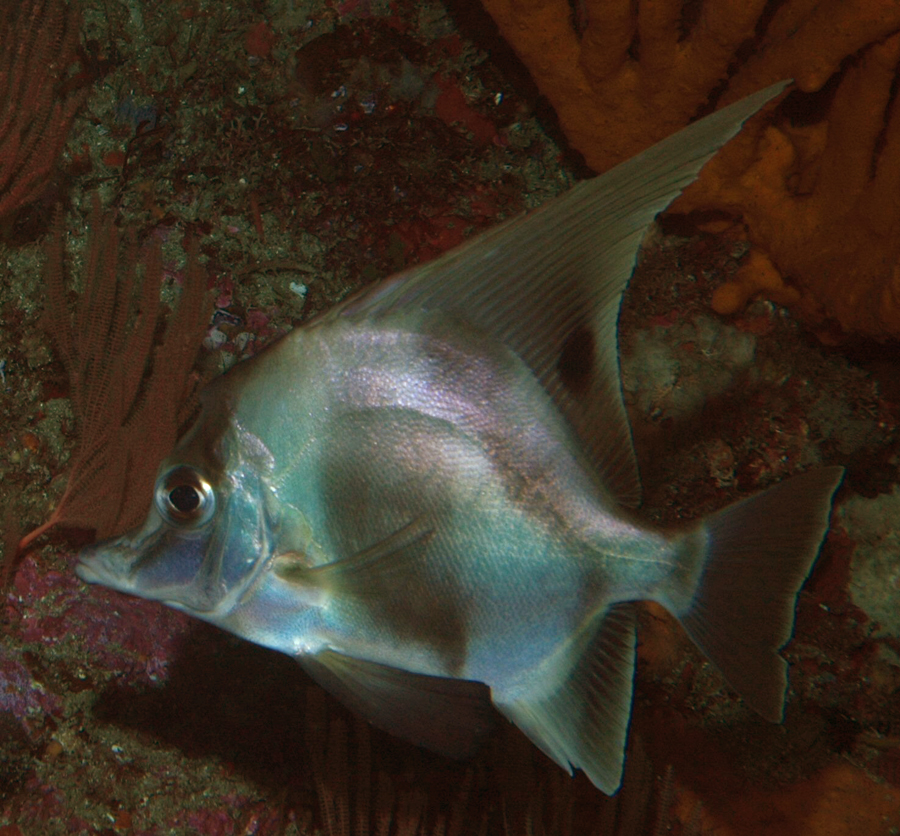Blackspot Boarfish, Zanclistius elevatus (Ramsay & Ogilby 1888)
Other Names: Black Spotted Boarfish, Black-spotted Boarfish, Boarfish, Duckfish, Longfin Boarfish, Long-finned Boarfish, One Spot Boarfish, Short Boarfish, Short Finned Boarfish

A Blackspot Boarfish, Zanclistius elevatus. Source: Ian Skipworth / Wikimedia Commons. License: CC BY Attribution-Noncommercial-ShareAlike
Summary:
A pale silvery-grey to yellowish-green boarfish with broad, oblique, darker bands on the body, and very tall dorsal fin with a prominent dark spot on the rear.
Cite this page as:
Bray, D.J. 2021, Zanclistius elevatus in Fishes of Australia, accessed 02 Jul 2025, https://fishesofaustralia.net.au/home/species/631
Blackspot Boarfish, Zanclistius elevatus (Ramsay & Ogilby 1888)
More Info
|
Distribution |
Found in southern Australia from Cape Moreton, southern Queensland, to just south of Dirk Hartog Island, Western Australia, and around Tasmania. Also at Lord Howe Island in the Tasman Sea. Elsewhere, the Blackspot Boarfish occurs in New Zealand waters north of about 41°S. The species is most often taken at depths of just less than 100 m, but it has been recorded to 540 m. It has a rather patchy distribution and is relatively common in some areas. |
|
Features |
Dorsal fin V-VIII, 25-29; Anal fin III, 12-17; Caudal fin 16-18; Pectoral fin 15-17; Pelvic fin I, 5; Lateral line scales 55-65. Body deep (55-67% SL); sides strongly compressed and flat; dorsal profile broadly rounded. Head of moderate size (32-43% SL), predominantly covered with exposed, rough, striated bones; eyes large; snout lightly built, somewhat elongate, dorsal profile deeply concave; mouth small, nearly horizontal; teeth of both jaws short, conical, set in broad bands anteriorly, bands narrowing along sides; vomer toothless; older specimens developing bony knob on nape. Scales moderately small, ctenoid, covering body and head, but absent from opercular bones; lateral line strongly arched, following dorsal profile of body. Dorsal fin continuous, spines increasing in length posteriorly, anterior soft dorsal rays much longer than posteriormost dorsal spine, sometimes extending past caudal fin, posterior edge of dorsal fin concave; anal fin with short base, posterior margin straight, nearly vertical, spines large and strong; caudal fin slightly emarginate. Pectoral fins elongate, upper rays much longer than lower. Pelvic fins large, spine strong. (Hardy 1994) |
|
Colour |
Pale grey to pale yellowish-green, with darker, oblique broad bands on the body beneath the dorsal fin; prominent dark spot posteriorly on dorsal fin. |
|
Fisheries |
Taken as bycatch in demersal trawl fisheries. The flesh is considered to be of high quality. |
|
Etymology |
The specific name is from the Latin elevatus (= raised), presumably in reference to the very tall sickle-shaped dorsal fin. |
|
Species Citation |
Histiopterus elevatus Ramsay & Ogilby, 1889, Proc. Linn. Soc. N. S. W. Ser. 2, 3: 1311. Type locality: off Port Jackson, New South Wales. |
|
Author |
Bray, D.J. 2021 |
|
Resources |
Blackspot Boarfish, Zanclistius elevatus (Ramsay & Ogilby 1888)
References
Gomon, M.F. 2008. Families Enoplosidae and Pentacerotidae. pp. 609-617 in Gomon. M.F., Bray, D.J. & Kuiter, R.H (eds). Fishes of Australia's Southern Coast. Sydney : Reed New Holland 928 pp.
Gomon, M.F., Glover, C.J.M. & Kuiter, R.H. (eds) 1994. The Fishes of Australia's South Coast. Adelaide : State Printer 992 pp. 810 figs.
Hardy, G.S. 1983. A revision of the fishes of the family Pentacerotidae (Perciformes). New Zealand Journal of Zoology 10: 177-220 figs 1-13
Hardy, G.S. 1994. Pentacerotidae. pp. 629-636, figs 553-559 in Gomon, M.F., Glover, C.J.M. & Kuiter, R.H. (eds). The Fishes of Australia's South Coast. Adelaide : State Printer 992 pp. 810 figs.
Hoschke, A., Whisson, G. & Moore, G.I. 2019. Complete list of fishes from Rottnest Island. pp. 150-161 in Whisson, G. & Hoschke, A. (eds) The Rottnest Island fish book. 2nd ed. Perth : Aqua Research and Monitoring Services.
Hutchins, J.B. & Swainston, R. 1986. Sea Fishes of Southern Australia. Complete field guide for anglers and divers. Perth : Swainston Publishing 180 pp.
Johnson, J.W. 2010. Fishes of the Moreton Bay Marine Park and adjacent continental shelf waters, Queensland, Australia. pp. 299-353 in Davie, P.J.F. & Phillips, J.A. Proceedings of the Thirteenth International Marine Biological Workshop, The Marine Fauna and Flora of Moreton Bay. Memoirs of the Queensland Museum 54(3)
Jordan, D.S. 1907. A review of the fishes of the family Histiopteridae found in the waters of Japan; with a note on Tephritis Günther. Proceedings of the United States National Museum 32(1523): 235-239.
Kuiter, R.H. 1993. Coastal Fishes of South-eastern Australia. Bathurst : Crawford House Press 437 pp.
Last, P.R., Scott, E.O.G. & Talbot, F.H. 1983. Fishes of Tasmania. Hobart : Tasmanian Fisheries Development Authority 563 pp. figs.
May, J.L. & Maxwell, J.G.H. 1986. Field Guide to Trawl Fish from Temperate Waters of Australia. Hobart : CSIRO Division of Marine Research 492 pp.
Paulin, C., Stewart, A., Roberts, C. & McMillan, P. 1989. New Zealand fish: a complete guide. National Museum of New Zealand Miscellaneous Series 19: 1-279.
Ramsay, E.P. & Ogilby, J.D. 1888. Descriptions of two new Australian fishes. Proceedings of the Linnean Society of New South Wales 2 3(3): 1310-1312.
Scott, T.D., Glover, C.J.M. & Southcott, R.V. 1974. The Marine and Freshwater Fishes of South Australia. Adelaide : Government Printer 392 pp. figs.
Trnski, T. 2015. 189 Family Pentacerotidae. pp. 1308-1313 in Roberts, C.D., Stewart, A.L. & Struthers, C.D. (eds). The Fishes of New Zealand. Wellington : Te Papa Press Vol. 4 pp. 1153-1748.
Yearsley, G.K., Last, P.R. & Ward, R.D. (eds) 1999. Australian Seafood Handbook. Hobart : CSIRO Marine Research 460 pp.



